
Cumberland is a U.S. city in and the county seat of Allegany County, Maryland. It is the primary city of the Cumberland, MD-WV Metropolitan Statistical Area. At the 2020 census, the city had a population of 19,076. Located on the Potomac River, Cumberland is a regional business and commercial center for Western Maryland and the Potomac Highlands of West Virginia.

Allegany State Park is a state park in western New York State, located in Cattaraugus County just north of the Allegheny National Forest in Pennsylvania. The park is divided into two sections: The Red House Area and the Quaker Run Area. It lies within the Allegheny Highlands forests ecoregion.

Vernacular architecture is building done outside any academic tradition, and without professional guidance. This category encompasses a wide range and variety of building types, with differing methods of construction, from around the world, both historical and extant, representing the majority of buildings and settlements created in pre-industrial societies. Vernacular architecture constitutes 95% of the world's built environment, as estimated in 1995 by Amos Rapoport, as measured against the small percentage of new buildings every year designed by architects and built by engineers.

A cottage, during England's feudal period, was the holding by a cottager of a small house with enough garden to feed a family and in return for the cottage, the cottager had to provide some form of service to the manorial lord. However, in time cottage just became the general term for a small house. In modern usage, a cottage is usually a modest, often cosy dwelling, typically in a rural or semi-rural location and not necessarily in England. The cottage orné, often quite large and grand residences built by the nobility, dates back to a movement of "rustic" stylised cottages of the late 18th and early 19th century during the Romantic movement.
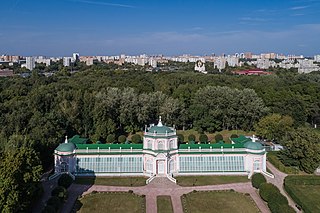
An orangery or orangerie was a room or a dedicated building on the grounds of fashionable residences of Northern Europe from the 17th to the 19th centuries where orange and other fruit trees were protected during the winter, as a very large form of greenhouse or conservatory.

Fort de Chartres was a French fortification first built in 1720 on the east bank of the Mississippi River in present-day Illinois. It was used as the administrative center for the province, which was part of New France. Due generally to river floods, the fort was rebuilt twice, the last time in limestone in the 1750s in the era of French colonial control over Louisiana and the Illinois Country.

American colonial architecture includes several building design styles associated with the colonial period of the United States, including First Period English (late-medieval), French Colonial, Spanish Colonial, Dutch Colonial, and Georgian. These styles are associated with the houses, churches and government buildings of the period from about 1600 through the 19th century.

Strathmore is a cultural and artistic venue and institution in North Bethesda, Maryland, United States. Strathmore was founded in 1981 and consists of two venues: the Mansion and the Music Center.

The Robert Allerton Park is a 1,517-acre (614 ha) park, nature center, and conference center located in the rural Piatt County township of Willow Branch, near Monticello, Illinois, on the upper Sangamon River. The park and manor house, The Farms, are attributed to owner Robert Allerton, industrialist heir, artist, art collector and garden designer. Robert donated the complex to the University of Illinois in 1946.
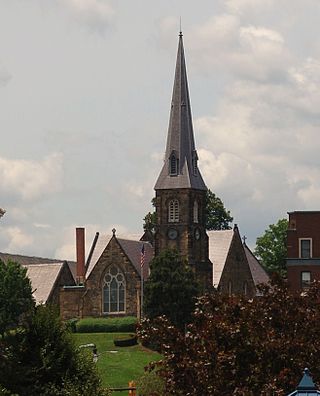
The Emmanuel Episcopal Church of Cumberland, Maryland in Cumberland's Historic District is built on the foundations of Fort Cumberland, where George Washington began his military career; earthworks from the fort still lie beneath the church. Although the Emmanuel parish dates from 1803, the cornerstone of the current native sandstone building was laid in 1849 and completed in 1851. The church contains original Tiffany stained-glass windows from three different periods and a scale model of Fort Cumberland. The grounds are part of the Fort Cumberland Walking Trail, signposted with plaques and detailed in a leaflet available from the visitor center.
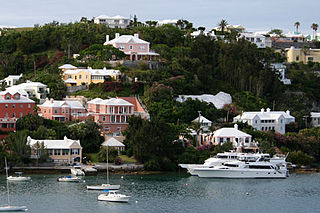
The architecture of Bermuda has developed over the past four centuries. The archipelago's isolation, environment, climate, and scarce resources have been key driving points, though inspiration from Europe, the Caribbean and the Americas is evident. Distinctive elements appeared with initial settlement in the early 17th century, and by the second half of that century features that remain common today began to appear.

National Park Service rustic – sometimes colloquially called Parkitecture – is a style of architecture that developed in the early and middle 20th century in the United States National Park Service (NPS) through its efforts to create buildings that harmonized with the natural environment. Since its founding in 1916, the NPS sought to design and build visitor facilities without visually interrupting the natural or historic surroundings. The early results were characterized by intensive use of hand labor and a rejection of the regularity and symmetry of the industrial world, reflecting connections with the Arts and Crafts movement and American Picturesque architecture.

Kelly Lynne Moran is an American actress, artist, author and builder. The Washington Times newspaper wrote "she is also one heck of a designer." She has a degree in Fine Arts from Frostburg State University, graduating in 1982 and continually trains at the Schuler School of Fine Arts in Baltimore, Maryland, painting in the 16th century Dutch Old Masters' style. She continued her education at the George Washington University in 1995 studying Landscape Design and the USDA Graduate School studying Botany, and Horticulture. Working as a landscape designer in the Washington D.C. metro area landed Moran on Fox 5 News in 2002, at 5:00 doing gardening segments.

The E.W. Marland Mansion is a 43,561 square feet (4,046.9 m2) Mediterranean Revival-style mansion located in Ponca City, Oklahoma, United States. Built by oil baron and philanthropist Ernest Whitworth (E.W.) Marland, as a display of wealth at the peak of the 1920s oil boom, the house is one of the largest residences in the southwestern United States, and is known as the "Palace on the Prairie." It was designated a National Historic Landmark in 1973, and is now a museum open to the public.

University Town Center, formerly New Town Center, is located in Hyattsville, Prince George's County, Maryland, United States. It was a planned urban center designed by Edward Durell Stone and located on a 105-acre (0.42 km2) parcel at the intersection of Belcrest Road and East-West Highway and across from the then new Prince George's Plaza. The initial construction on this development took place in 1963–64; its buildings are listed on the National Register of Historic Places. A second phase commenced after the opening of the Hyattsville Crossing station, Washington Metro rapid transit station in 1993.

Cadmans Cottage or Cadman's Cottage is a heritage-listed former water police station and sailor's home and now visitor attraction located at 110 George Street in the inner city Sydney suburb of The Rocks in the City of Sydney local government area of New South Wales, Australia. The property is owned by NSW Office of Environment and Heritage, an agency of the Government of New South Wales. It was added to the New South Wales State Heritage Register on 2 April 1999.

The Headquarters of George Washington is a historic site located at 38 Greene Street in Cumberland, Maryland in central Allegany County. The centerpiece and primary attraction at the site is a historic log cabin twice occupied by George Washington, the first President of the United States of America. The cabin resides in an area known today as Riverside Park, but was originally built about 2 blocks away, the original site is located nearby at 16 Washington Street.
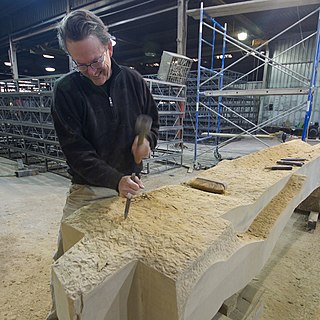
Richard Rhodes is a Seattle, Washington-based sculptor, stonemason, entrepreneur, and scholar of stonework worldwide.

The French ambassador's residence in Washington, D.C. is located at 2221 Kalorama Road, N.W., in the Kalorama neighborhood of northwest Washington, D.C.
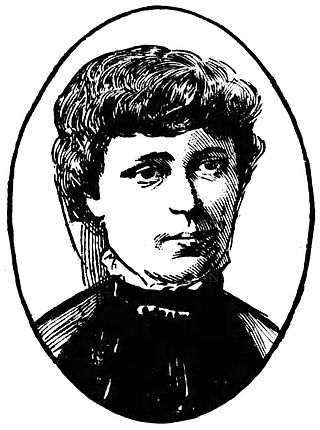
Emily Elizabeth Holman, better known by her professional name of E. E. Holman, was one of the first female architects of Pennsylvania. She was active from the 1880s to her retirement in 1914 and was responsible for planning several important historical sites like the Goold House in the Wilder Village Historic District, Wilder, Vermont and the National Park Seminary among many others.






















